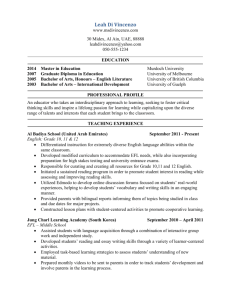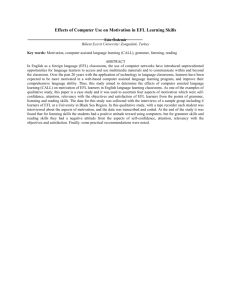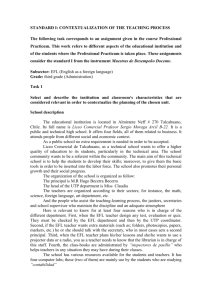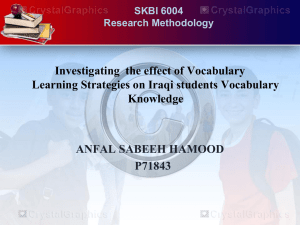integrating multimedia technology in a high school efl program
advertisement
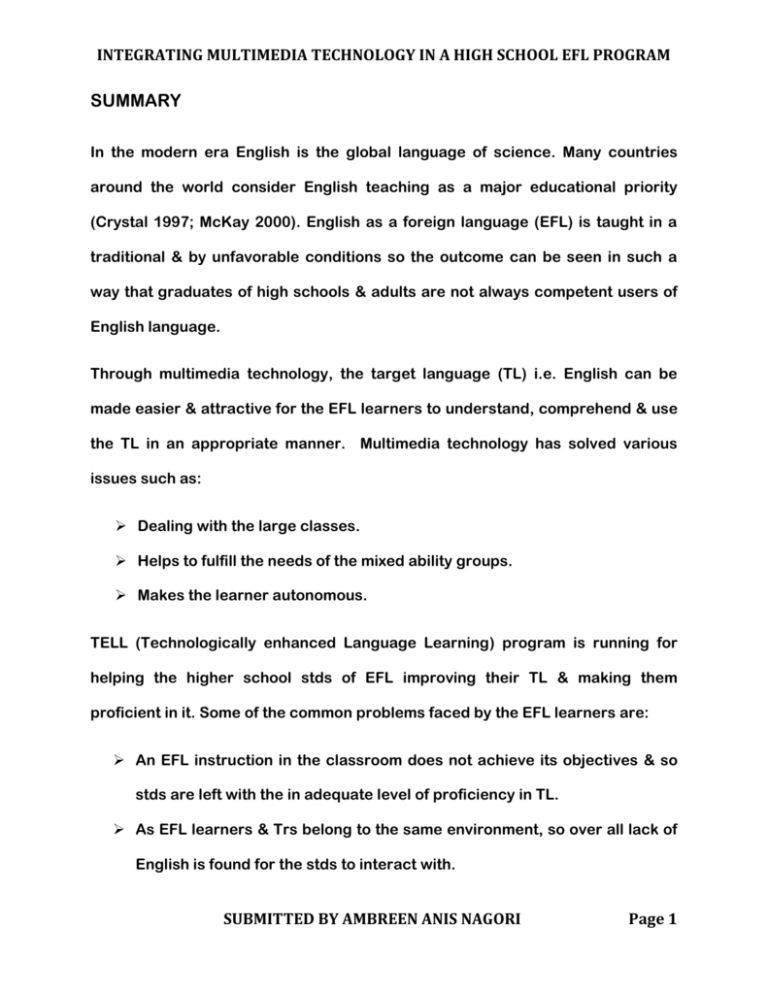
INTEGRATING MULTIMEDIA TECHNOLOGY IN A HIGH SCHOOL EFL PROGRAM SUMMARY In the modern era English is the global language of science. Many countries around the world consider English teaching as a major educational priority (Crystal 1997; McKay 2000). English as a foreign language (EFL) is taught in a traditional & by unfavorable conditions so the outcome can be seen in such a way that graduates of high schools & adults are not always competent users of English language. Through multimedia technology, the target language (TL) i.e. English can be made easier & attractive for the EFL learners to understand, comprehend & use the TL in an appropriate manner. Multimedia technology has solved various issues such as: Dealing with the large classes. Helps to fulfill the needs of the mixed ability groups. Makes the learner autonomous. TELL (Technologically enhanced Language Learning) program is running for helping the higher school stds of EFL improving their TL & making them proficient in it. Some of the common problems faced by the EFL learners are: An EFL instruction in the classroom does not achieve its objectives & so stds are left with the in adequate level of proficiency in TL. As EFL learners & Trs belong to the same environment, so over all lack of English is found for the stds to interact with. SUBMITTED BY AMBREEN ANIS NAGORI Page 1 INTEGRATING MULTIMEDIA TECHNOLOGY IN A HIGH SCHOOL EFL PROGRAM Most of the stds began to learn formal English instructions at the age of 12 or 13. There are very few periods assigned to English on weekly basis. Mostly classes are of big sizes & it is very difficult for a Tr to control it. As the stds are of mixed ability groups so their needs are different from each other & it is very difficult to cater each std’s need in the class. Very low salaries of Trs. Untrained Trs of English language. An example of a high school in Caracas is taken that decided to make some major changes in their school’s educational program because the management found some lacking in the methodology of their English teaching program. So they adapted the multimedia approach that brought the positive change in dealing with the problems associated with EFL classrooms. In 1999 the HISEP (High School English Program) was implemented with the key to join multimedia technology with the traditional classroom instructions. This conclusion was not meant to replace the classrooms, textbook or Tr but it supplements them the hope of achieving the program. The general objective is to develop all the four skills (reading, writing, listening & speaking) of the stds & to enhance their vocabulary as well as grammar too. Some of the sub skills related with the grammar & the vocabulary are: To increase std’s awareness & understanding of their own learning processes. SUBMITTED BY AMBREEN ANIS NAGORI Page 2 INTEGRATING MULTIMEDIA TECHNOLOGY IN A HIGH SCHOOL EFL PROGRAM To develop an autonomous attitudes in stds toward language learning. To help stds to recognize & incorporate pertinent strategies that helps them learning their own. To encourage std to think critically & express themselves reflectively. (Pino-Silva & Antonini 1999, 2000) Over all multimedia technology had a positive change & so its integration with the existent high school was a logical step. Many researchers have reported on the theoretical constructs that supports the use of the multimedia technology for EFL instructions. (Jonassen 2000; Kitao 1995; Kang 1999; Pino-Silva 2002; 2004; Stepp Greany 2002) Allows std to work individually at a computer station, at their own pace & according to their own needs. Helps Trs to deal more effectively with a large group of stds. Makes the introduction & presentation of content more dynamic & attractive for the stds. Increases std’s motivation due to the interactive nature of the activities. Trains stds to self monitor & to self assess their progress, which promotes autonomous learning. Promotes a task based approach to learning. Allows stds to experience more real life & communicatively meaningful language situations & context. SUBMITTED BY AMBREEN ANIS NAGORI Page 3 INTEGRATING MULTIMEDIA TECHNOLOGY IN A HIGH SCHOOL EFL PROGRAM Introduces a variety of print, audio & visual materials that match different std learning styles & preferences. In classroom it also offers additional possibilities for designing communicative tasks. It allows oral & written communication both. To engage stds in distance learning & e-learning. Videos more appealing & entertaining for the stds. Expose stds to authentic language in natural situations. Provides a situational & visual context to language interactions. Expose stds to authentic non verbal elements of language. Videos more appealing & entertaining for the stds. Expose stds to authentic language in natural situations. Provides a situational & visual context to language interactions. Expose stds to authentic non verbal elements of language. (Anderson 2003; Belz2002; Dudeney 2000; Jonassen 2000; Pino-Silva 2002) Practically, Trs should never think of technology as a remedy that solves all the problems associated with the language teaching. Tr should be more realistic & responsible towards establishing multimedia technology environment. Some issues should be considered before deciding to create such centers like TELL such as: Tr’s resistance to technology, because of a lack of the interest or uncertainty regarding its effectiveness. SUBMITTED BY AMBREEN ANIS NAGORI Page 4 INTEGRATING MULTIMEDIA TECHNOLOGY IN A HIGH SCHOOL EFL PROGRAM It is potential to limit the task or the repetition of the task causes boredom & passive learning. (Jonassen 2000) The cost of maintaining or upgrading multimedia equipment. Concerns about the actual autonomy because it is the Tr who selects the options for the stds to work on. Keeping it in view, HISEP was designed & implemented. A TELL centre was also developed in accordance with the theoretical findings reported by language teaching professionals. Today it is known as the English learning centre (ELC). ELC is an integral multimedia environment. Many computers & stds are connected with each other through ELC. Activities at ELC both complement & reinforce what is being taught in the classroom. CONCLUSION To conclude I can say that the suggested solution is the usage of multimedia technology, its integration with the traditional methods of teaching can help to produce an autonomous std having proficiency in TL i.e. English. It should also be taken in consideration that all schools do not have the resources available, space or capacity to install such kind of multimedia centers like ELC. That is why its not compulsory to have such kinds of multimedia setups at our schools but at least a Tr should be aware of the different technological advancements i.e. old methodologies of teaching through audio cassettes to CDs & DVDs because this shift of paradigm for a Tr is enough to make the EFL SUBMITTED BY AMBREEN ANIS NAGORI Page 5 INTEGRATING MULTIMEDIA TECHNOLOGY IN A HIGH SCHOOL EFL PROGRAM stds to attain maximum advantage & exposure to the TL. This change towards teaching attitudes towards the multimedia technology can change the entire view of the entire institutions too. Technology is achievable & so it depends on the Tr that how to acquire it or how to integrate it in the curriculum. SUBMITTED BY AMBREEN ANIS NAGORI Page 6 INTEGRATING MULTIMEDIA TECHNOLOGY IN A HIGH SCHOOL EFL PROGRAM OPEN ENDED QUESTIONS 1. Is it possible for a teacher to acquire the multimedia technology into the curriculum for his/her EFL learners to become proficient in the TL (English)? 2. Do you think that multimedia technology can really help EFL learners to acquire more accuracy, proficiency and fluency in TL? BIBLIOGRAPHY Carlos. A. Mayora. 2006. Integrating Multimedia Technology in a High School EFL Program. English Teaching Forum 44 (3): 14-21. SUBMITTED BY AMBREEN ANIS NAGORI Page 7

